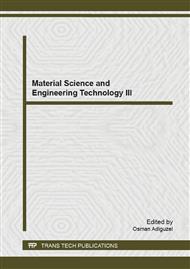p.307
p.314
p.318
p.322
p.330
p.336
p.340
p.344
p.348
Saccharose as a New Space Holder Material for Porous Titanium Implant Formation
Abstract:
This paper investigates the properties of Ti scaffolds with a porosity of 73%. In the processing route, a new space holder material was applied - saccharose, commonly known as table sugar. Porous Ti was made by the dissolution of sugar crystals from the Ti-sugar green compact and final sintering of the remaining Ti scaffold. The sintered scaffolds showed uniform pore distribution. The pores had polyhedral shape and their dimensions reached 1 mm. The scaffolds were made and investigated with respect to possible medical applications. After all processing stages, the surface was oxidized and showed average wettability with the lowest wetting angle of 81.5o, which was strongly correlated with the condition of the surface. The chemical etching in an HF solution resulted in a strong wettability improvement. Due to very high porosity, the compression strength (1.48 MPa) and Young’s modulus (33.7 MPa) of the scaffolds were relatively low.
Info:
Periodical:
Pages:
330-335
Citation:
Online since:
April 2015
Authors:
Keywords:
Price:
Сopyright:
© 2015 Trans Tech Publications Ltd. All Rights Reserved
Share:
Citation:


